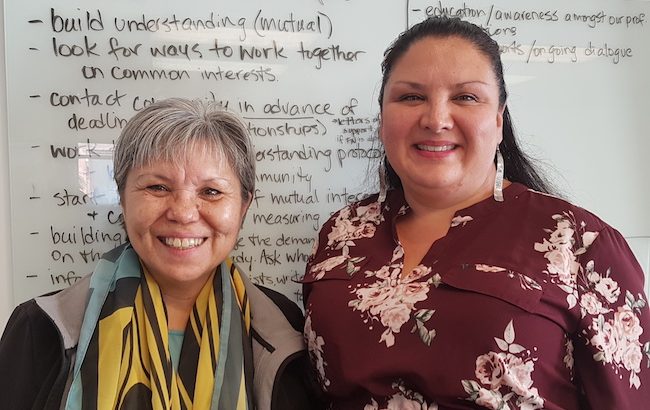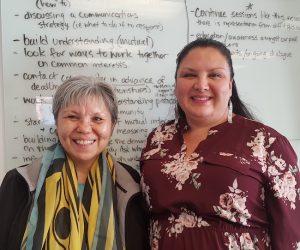Sarah Boon, Science Borealis Core Team member
On Saturday, November 17, Science Borealis co-hosted a workshop on Building Indigenous Relations in an Age of Reconciliation in Victoria, BC. The workshop was co-hosted with Vancouver’s Curiosity Collider and the Science Writers and Communicators of Canada (SWCC), with in-kind support from the Hakai Institute.
We spent the morning of November 17thin the Hakai Institute boardroom, with a gorgeous view of Victoria’s Inner Harbour, on the traditional territories of the Lekwungen peoples (today represented by the Songhees and Xwsepsum (Esquimalt) Nations).
Our presenters, Michelle Washington and Lou-ann Neel, spoke for the first half of the session, and we worked in breakout groups for the second half of the session to come up with best practices when interacting with First Nations communities.
Washington was born and raised in the village of Tla’amin, a Northern Coast Salish Nation. She has degrees in Public Sector Management and Aboriginal Governance and is currently studying Anthropology. She managed the exhibition “Our Living Languages” for the First Peoples’ Cultural Council at the Royal BC Museum. She has also been involved in programming with the Office of Indigenous Affairs at the University of Victoria. Neel is from the Mamalilikulla and Kwagiulth people of the Kwakwaka’wakw Nation of northern Vancouver Island and surrounding region. Not only is she schooled in public administration of Aboriginal governments, she is also a practising artist. She is currently the Repatriation Specialist at the Royal BC Museum.
Workshop attendees weren’t limited to science writers and communicators. We had an earth scientist and a software engineer with a geoscience company, a commercial fishing liaison, a consulting biologist, the Coordinator of the Coast and Ocean Risk Communication Community of Practice, and more. We also hosted a broad range of career stages, from undergraduates through grad students and early career researchers, to more established communicators like Hakai Magazine‘s Adrienne Mason, veteran science communicator Claire Eamer, and environment writer Frances Backhouse.
The workshop helped attendees identify ways to start meaningful conversations and explore unconscious bias around their writing and community interactions. It gave them hands-on learning and greater confidence when working on issues that concern First Nations groups. Most attendees joined us for lunch after the workshop and spoke of how valuable it had been for them, and the new ideas they had to bring back to their own communities of practice.
Some examples of best practices we came up with included:
- Connect with your local First Nations community before you need to speak with them. Develop a relationship with them so you know who to talk to – and they know you – when it comes time to interview people or request support letters for grants.
- Find out if your local First Nation has their own rules of engagement when working with people outside their Nation.
- Remember that individuals you speak with from a particular Nation may not represent the perspective of the Nation as a whole. They are speaking only for themselves unless they state otherwise.
- Bring what you’ve learned about working with First Nations back to your community of practice, so you can share what you’ve learned and help others by modelling repeatable behaviours.
We came up with many more best practices, which we’ll be collating in a single document via SWCC for communicators and writers looking to connect with Indigenous people. We’ll spread the word when it’s ready to be released.
This topic is obviously important across disciplines: there is a Conservation at the Interface of Indigenous Knowledge & Ecology event at the Shaw Centre for the Salish Sea on December 10, and the Science and Technology Action Network (STAN) is hosting a webinar on practical tips and applications for incorporating Indigenous perspectives in meaningful way on December 12.
Thanks again to Michelle Washington and Lou-ann Neel for a highly relevant, hands-on workshop.
~30~
Resources
- Truth and Reconciliation Commission (TRC) Calls to Action http://nctr.ca/assets/reports/Calls_to_Action_English2.pdf
- Media and Reconciliation, Sections 84–86 (pages 9–10)
- United Nations Declaration on the Rights of Indigenous Peoples (UNDRIP) https://www.un.org/esa/socdev/unpfii/documents/DRIPS_en.pdf
- Resolution Adopted by the General Assembly (pages 1-4)
- Articles 1-5 (pages 4-5)
- Articles 11-12 (page 6)
- Article 16 (pages 7-8)
- Article 31 (pages 11-12)
- Royal Commission on Aboriginal Peoples (RCAP) http://data2.archives.ca/e/e448/e011188230-01.pdf:
- Section 4: A Matter of Trust (pages 16-17)
- Additional readings:
- Harding, R. 2005. The Media, Aboriginal People, and Common Sense. The Canadian Journal of Native Studies XXV 1: 311-335. http://www3.brandonu.ca/cjns/25.1/cjnsv25no1_pg311-335.pdf
- Indigenous Organizations
- Union of BC Indian Chiefs Timeline https://www.ubcic.bc.ca/timeline
- Assembly of First Nations http://www.afn.ca/Home/
- BC Assembly of First Nations http://bcafn.ca/
- Native Brotherhood https://nativebrotherhood.ca/
- First Nations Summit http://fns.bc.ca/
- Guide to Indigenous Organizations & Services in BC – downloadable Excel Spreadsheet https://www2.gov.bc.ca/gov/content/governments/indigenous-people/aboriginal-organizations-services
- Indigenous Voices
- The Native Voice newspaper archives https://web.archive.org/web/20150204000249/http://nativevoice.bc.ca/
- Download Indigenous language keyboards from languagegeek.com
- UBC Journalism http://indigenousreporting.com/
- Working with Indigenous Communities
- Panel summary: Risk Communication at the Local Level: Towards Meaningful Community Collaborations on Environmental Hazards https://drive.google.com/file/d/1HHdYoDC_iXB6qcIfIuUbJqzxcbLvtYJG/view
- ACUNS Ethical Principles for the Conduct of Research in the North http://acuns.ca/wp-content/uploads/2010/09/EthicsEnglishmarch2003.pdf
- ACUNS Community Engagement: Research Excellence in Yukon http://acuns.ca/wp-content/uploads/2013/09/YUKON-ENGLISH-WEB.pdf
- ACUNS Community Engagement: Research Excellence in the NWT http://acuns.ca/wp-content/uploads/2018/07/2018-NWT_English-Web.pdf
- Assembly of First Nations: First Nations Ethics Guide on Research and Aboriginal Traditional Knowledge https://www.afn.ca/uploads/files/fn_ethics_guide_on_research_and_atk.pdf
- Model Tribal Research Code by the American Indian Law Center https://ccph.memberclicks.net/assets/Documents/CBPRCurriculum/AppendixF/mdl-code.pdf
- Working with Indigenous Communities: National Inuit Strategy on Research https://www.itk.ca/national-strategy-on-research/
- Books
- Elements of Indigenous Style, by Gregory Younging https://www.goodreads.com/book/show/34483699-elements-of-indigenous-style
- Seeing Red – A History of Natives & Canadian Newspapers, by Mark Cronlund Anderson and Carmen L. Robertson https://www.goodreads.com/book/show/12047096-seeing-red
- Why Indigenous Literatures Matter, by Daniel Heath Justice https://www.goodreads.com/book/show/26490905-why-indigenous-literatures-matter





